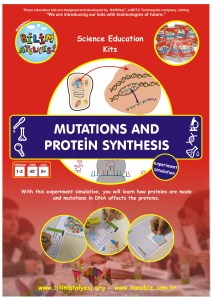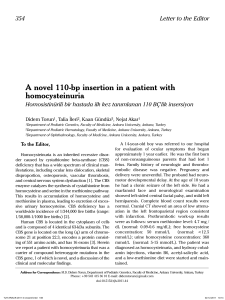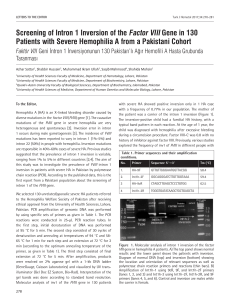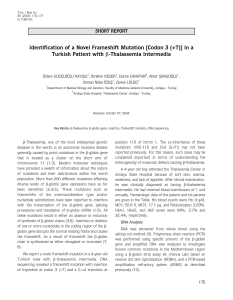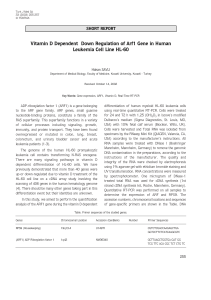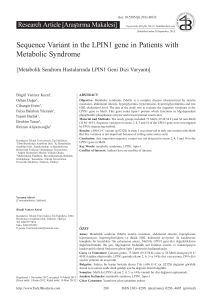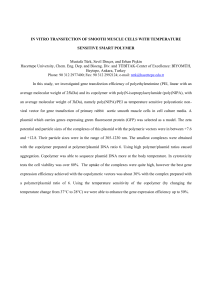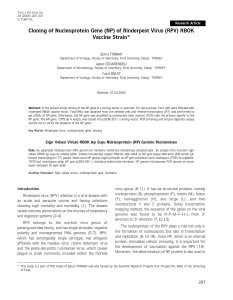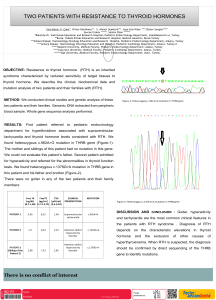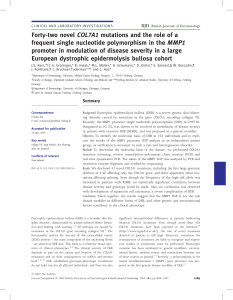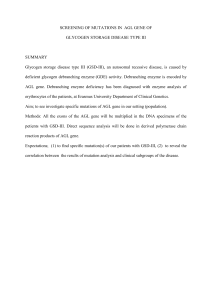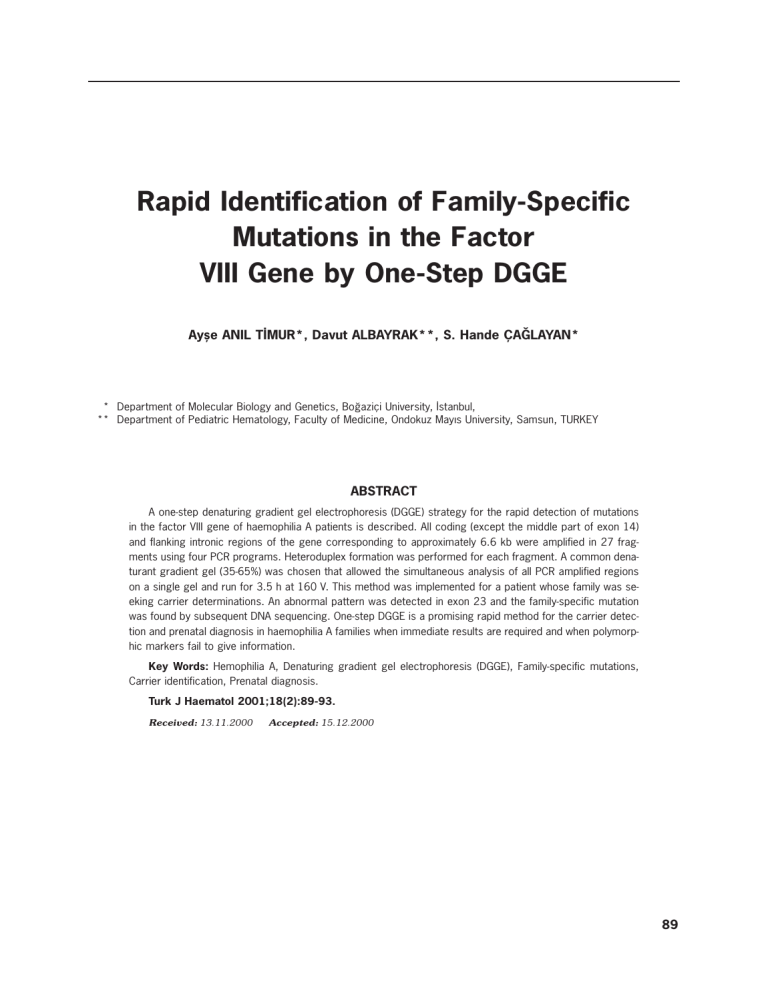
Rapid Identification of Family-Specific
Mutations in the Factor
VIII Gene by One-Step DGGE
Ayfle ANIL T‹MUR*, Davut ALBAYRAK**, S. Hande ÇA⁄LAYAN*
* Department of Molecular Biology and Genetics, Bo¤aziçi University, ‹stanbul,
** Department of Pediatric Hematology, Faculty of Medicine, Ondokuz May›s University, Samsun, TURKEY
ABSTRACT
A one-step denaturing gradient gel electrophoresis (DGGE) strategy for the rapid detection of mutations
in the factor VIII gene of haemophilia A patients is described. All coding (except the middle part of exon 14)
and flanking intronic regions of the gene corresponding to approximately 6.6 kb were amplified in 27 fragments using four PCR programs. Heteroduplex formation was performed for each fragment. A common denaturant gradient gel (35-65%) was chosen that allowed the simultaneous analysis of all PCR amplified regions
on a single gel and run for 3.5 h at 160 V. This method was implemented for a patient whose family was seeking carrier determinations. An abnormal pattern was detected in exon 23 and the family-specific mutation
was found by subsequent DNA sequencing. One-step DGGE is a promising rapid method for the carrier detection and prenatal diagnosis in haemophilia A families when immediate results are required and when polymorphic markers fail to give information.
Key Words: Hemophilia A, Denaturing gradient gel electrophoresis (DGGE), Family-specific mutations,
Carrier identification, Prenatal diagnosis.
Turk J Haematol 2001;18(2):89-93.
Received: 13.11.2000
Accepted: 15.12.2000
89
An›l Timur A, Albayrak D, Ça¤layan SH.
INTRODUCTION
Hemophilia A is an X-linked bleeding disorder caused by the deficiency or absence of
the coagulation protein Factor VIII (FVIII).
Molecular analysis of the FVIII gene has revealed a variety of mutations almost unique
to each family including single base substitutions, deletions, duplications and insertions that are listed in the haemophilia A database (1; http://europium.csc.mrc.ac.uk).
One type of inversion, however, disrupting
the FVIII gene in intron 22 accounts for 4045% of the severe cases[2].
The detection of family-specific mutations
provides the most accurate and reliable hemophilia A diagnosis and carrier detection.
However, due to the large size and complexity
of the FVIII gene, it is very difficult to locate
mutations by direct sequencing. A number of
screening methods have been implemented
for the detection of haemophilia A mutations
including chemical cleavage of mismatch
(CCM)[3,4], single-strand conformation polymorphism (SSCP)[5,6], and denaturing gradient gel electrophoresis (DGGE)[7-9].
DGGE has been shown to detect DNA molecules differing by as little as a single base
change[7,10]. The efficiency of the method is
estimated to be about 98-100%. Although it
has been reported that DGGE is one of the
most sensitive methods used to identify FVIII
mutations, the detection power of DGGE is
shown to be between 82-86% for the FVIII gene[8,9,11]. Consequently, the point that mutations that cause hemophilia A may reside in
regions not routinely screened in the FVIII
gene or in some other genomic loci.
A fine DGGE screening of the FVIII gene
involves the analysis of each fragment separately since each fragment requires a different denaturant gradient. This is the most
systematic and economic way for screening
large samples of patients. In this manner 32
hemophilia A mutations have been identified
in Turkish patients[12]. However, the method
is not feasible for the detection of a mutation
90
Rapid Identification of Family-Specific Mutations in the Factor
VIII Gene by One-Step DGGE
in only one family. Similar difficulties are encountered in other large genes where heterogenous point mutations cause the disease. A
modified DGGE method called “broad-range”
was first applied to human phenylalanine
hydroxylase (PAH) gene by adapting a 0-80%
gradient gel to 13 exonic fragments so that
they are all analyzed in one gel[13]. Herein,
we report a one-step DGGE system that allowed the simultaneous analysis of all PCRamplified fragments of the FVIII gene, enabling scanning of all coding regions of a patient on a single DGGE gel.
MATERIALS and METHODS
Polymerase chain reactions (PCRs) for all
25 exons, all corresponding flanking regions,
and 5’ and 3’ portions of exon 14 (14a and
14b, respectively) were carried out in 25 µL
reaction mixture containing 1X PCR buffer
containing of 1.5 mM MgCl2, 0.2 mM dNTP,
2.5-10 pmoles of each primer, 0.5 U of MBI
Fermantas Taq DNA Polymerase (Vilnius,
Lithuania) and 0.5-1 µg of genomic DNA on a
MJ Research PTC-200 Peltier Thermal Cycler
(Massachusetts, USA). The T7 SequenaseTM
PCR Product Sequencing Kit and α-[35S]dATP were used for the sequence analysis.
DNA sequencing reactions were performed
according to manufacturer’s protocols
(Amersham LIFE SCIENCE, Inc., Arlington
Heigths, Illinois, USA).
Primer and GC-clamp sequences are as
determined by Schwaab et al, 1995 with the
exception of primers for exon 11-13,15,19,
21 and 26 that are very sligthly different
than these primers (Exon 11: F(GC)xTGGTTTTGCTTGTGGGTAG, R-ATAAGGGGACATCAACTGAGAATGAA; Exon 12:
F-(GC)xCCTTTCAATATATGTAATTAACAG, RATTCACCACCCACTGGACTTAAGTGCTG;
Exon 13: F-(GC)xGATGTGTCTAAATCTCT
TTTCCCCATTG, R-ATATAATAACTAACCTGG
GTTTTCCATC; Exon 15: F-(GC)xCACCTAGGAAAATGAGGATGTGAGGC, R-TTCTTGTAA
TTCCACTGTCCTTAACT; Exon 19: F-(GC)xTT
AGTGAAAAGAAATAATTTCTGTT, R-GTAGGC
TGAGTAGGTAGGGAACCTCTG; Exon 21: F-
Turk J Haematol 2001;18(2):89-93
Rapid Identification of Family-Specific Mutations in the Factor
VIII Gene by One-Step DGGE
GAATTTAATCTCTGATTTCTCTAC, R- F-(GC)x
GAGTGAATGTGATACATTTCCCATCA; Exon
26: F- F-(GC)xAGCGTCTGTGCTTTGCAGTG,
R-TGACGGCAGTGGCAGGTGCT; (GC)x =39).
For PCR amplification, after an initial denaturation at 94°C for 5 min, 35 cycles were
performed involving a 35s denaturation at
94°C, 1 min 30s annealing at 51-61°C, and 1
min synthesis at 72°C. PCR was completed
with a 5 min extension at 72°C. The matching PCR annealing temperatures of 27 were
grouped and amplified in four different thermal cycler programs. PCR products were between 207-388 bp including a 39 bp GCclamp. For heteroduplex formation, equal
amounts of PCR products from patient and
normal DNA were combined for each exon,
separately. The mixture containing about 20
ng of PCR product was denatured for 10 min
at 98°C and allowed to reanneal for 10 min
at 60°C.
One-step DGGE was carried out at 160 V
for 3.5 h on a Hoefer Pharmacia SE600 apparatus (Hoefer Pharmacia Biotech Inc., San
Francisco, California, USA) at a 59°C constant temperature of the 1X tris-acetic acidEDTA (TAE) buffer. The gel slabs were 0.75
mm-thick, 15 cm-wide and 16 cm-long. Gels
were visualised by silver staining and appropriate PCR products were loaded for proper
and stronger visualisation[14].
RESULTS
A 35-65% denaturing concentration range with a 7% acrylamide content (37.5:1) was
tested to be optimal to analyse all fragments
in one-step DGGE using known mutations
in 19 different exons as controls. One-step
DGGE was applied for the detection of point
mutations in a haemophilia A patient screening all 27 PCR fragments comprising 25
exons and two portions of exon 14. Patient
DNA was heteroduplexed with a normal DNA
for all fragments and applied on DGGE gels.
Figure 1A and 1B show the DGGE pattern.
Heteroduplexes were detected in exon 23
(Fig 1B).
Turk J Haematol 2001;18(2):89-93
An›l Timur A, Albayrak D, Ça¤layan SH.
Some artefacts are present in exons 11,
12, 13; under the real bands and in exon 2
and exon 24; above the real band. However,
they can be distinguished from real bands as
they are generally stained lighter with silver
nitrate. They possibly result from unspecific
PCR products, macromolecular impurities,
detergent micelles or other anionic material
in the sample or in the buffer.
The presence of a point mutation in exon
23 of the patient was confirmed by direct sequencing. The patient had a novel G to C
transversion at codon 2163 (Arg2163Pro) in
exon 23 corresponing to a CpG site of the
FVIII gene (patient 147HA581, Timur et al.
submitted).
DISCUSSION
DGGE is proven to be a very sensitive mutation screening method with applications to
both linkage and mutation analysis of haemophilia A. It can be costly, laborious and time-consuming to start with but once established, it can be simpler and routine. Using
one-step DGGE strategy it became possible to
scan all coding regions of the FVIII gene in a
common denaturing gradient gel that takes
only two days.
One-step DGGE is highly promising for
the rapid detection of family-specific mutations and therefore, for the accurate carrier
detection and prenatal diagnosis in haemophilia A when immediate results are required
and especially when linkage markers are not
informative. The banding pattern of the exon
suspected to carry the mutation could also
be used in linkage analysis to follow the inheritance of the disorder in the family without further DNA sequence analysis to identify
the mutation.
ACKNOWLEDGEMENTS
This study was supported by Boğaziçi
University Research Fund Project 97BO107
and TÜBİTAK (Turkish Scientific and Technical Research Council) project number
TBAG-1397. We thank Prof. Klaus Olek for
91
Rapid Identification of Family-Specific Mutations in the Factor
VIII Gene by One-Step DGGE
An›l Timur A, Albayrak D, Ça¤layan SH.
A
Exons
B
Exons
1
14b
2
15
3
16
4
5
17
6
18
7
19
8
20
9
21
10
22
11
12
13
14a
23*
24
25
26
Figure 1 AB. One-step DGGE analysis of the FVIII gene. Numbers on each lane refer to exon numbers. A. Exonic fragments 1-14a. B. Exonic fragments 14b-26. *points to the lane where an abnormal pattern was observed
in exon 23. Heteroduplex patterns are indicated by arrows.
providing the primers and Gustavo MartinezNoel for helpful suggestions.
4.
REFERENCES
1.
2.
3.
92
Kemball-Cook G, Tuddenham, EGD, Wacey AI. The
factor VIII structure and mutation resource site:
HAMSTeRS version 4. Nucleic Acids Res 1998;26:
216-9.
Lakich D, Kazazian, HHJR, Antonarakis SE, Gitschier J. Inversions disrupting the factor VIII gene are
a common cause of severe heamophilia A. Nat Genet 1993;5:236-41.
Cotton RG, Rodrigues NR, Campbell RD. Reactivity
of cytosine and thymine in single-base pair mismatches with hydroxylamine and osmium tetraoxide and
5.
6.
its applications to the study of mutations. Proc Natl
Acad Sci USA 1988;85:4397-401.
Freson K, Peerlinck K, Aguirre T, Arnout, J, Vermylen, J, Cassiman J-J, Matthijs G. Fluorescent chemical cleavage of mismatches for efficient screening of
the factor VIII gene. Hum Mutat 1998;11:470-9.
Orita M, Suzuki Y, Sekiya T, Hayashi K. Rapid and
sensitive detection of mutations and DNA polymorphisms using the polymerase chain reaction. Genomics 1989;5:874-9.
Pieneman WC, Deutz-Terlouw PP, Reitsma PH, Briet E. Screening for mutations in haemophilia A patients by multiplex PCR-SSCP, Southern blotting and
RNA analysis: The detection of a genetic abnormality in the factor VIII gene in 30 out of 35 patients.
Br J Haematol 1995;90:442-9.
Turk J Haematol 2001;18(2):89-93
Rapid Identification of Family-Specific Mutations in the Factor
VIII Gene by One-Step DGGE
7.
Myers RM, Maniatis T, Lerman LS. Detection and
localization of single base changes by denaturing gradient gel electrophoresis. Methods Enzymol 1987;
155:501-27.
8. Higuchi M, Antonarakis SE, Kasch L, Oldenburg J,
Economou-Petersen E, Olek K, Arai M, Inaba H,
Kazazian HHJR. Molecular characterization of mildto-moderate hemophilia A: Detection of the mutation in 25 of 29 patients by denaturing gradient gel
electrophoresis. Proc Natl Acad Sci USA
1991;88:8307-11.
9. Schwaab R, Oldenburg J, Schwaab U, Johnson
DJD, Schmidt W, Olek K. Characterization of mutations within the factor VIII gene of 73 unrelated mild
and moderate haemophiliacs. Br J Haematol
1995;91:458-64.
10. Sheffield VC, Cox DR, Lerman LS, Myers RM. Attachment of a 40-base-pair G+C-rich sequence (GCclamp) to genomic DNA fragments by the polymerase chain reaction results in improved detection of
single base changes. Proc Natl Acad Sci USA 1989;
86:232-6.
11. Schwaab R, Oldenburg J, Lalloz MRA, Schwaab U,
Pemberton S, Hanfland P, Brackmann HH, Tuddenham EGD, Michaelides K. Factor VIII gene mutations found by a comparative study of SSCP, DGGE
Turk J Haematol 2001;18(2):89-93
An›l Timur A, Albayrak D, Ça¤layan SH.
and CMC and their analysis on a molecular model of
factor VIII protein. Hum Genet 1997;101:323-32.
12. Timur AA, Gürgey A, Aktuğlu G, Kavaklı K, Canatan D, Olek K, Çağlayan SH. Molecular Pathology of
hemophilia A in Turkish patients: Identification of
36 independent mutations (submitted to Human Mutation).
13. Guldberg P, Güttler F. ‘Broad-range’ DGGE for single-step mutation scanning of entire genes: application to human phenylalanine hydroxylase gene. Nucleic Acids Res 1994;22:880-1.
14. Beidler JL, Hilliard PR, Rill RL. Ultrasensitive staining of nucleic acids with silver. Anal Biochem
1982;126:374-80.
Address for Correspondence:
S. Hande ÇAĞLAYAN, MD
Department of Molecular Biology and Genetics
Boğaziçi University, 80815
Bebek, İstanbul, TURKEY
93

